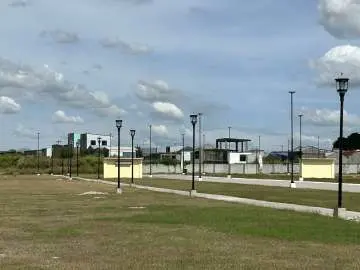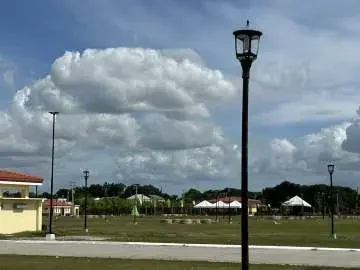Project Name: Lighting Upgrade for Outdoor Public Spaces in the Philippines
Project Location: A park square area in the Philippines
Core Product: SRESKY SLL-10F Solar Landscape Lamps
Project Objective: To enhance nighttime safety, usability, and aesthetics of public spaces, while promoting the concept of sustainable development.

Case Summary
This case highlights the successful application of SRESKY SLL-10F solar landscape lamps in an outdoor park square in the Philippines. By examining the project background, technical solution, implementation process, and expected outcomes, it illustrates how the SLL-10F, with its superior performance, environmental adaptability, and intelligent features, has delivered significant social and environmental benefits to the local community, setting a benchmark for outdoor public lighting.
Project Background and Needs Analysis
Project Background
As a tropical developing country, the Philippines faces various challenges in providing reliable and cost-effective lighting for outdoor public areas such as park plazas. Traditional grid-powered systems are often costly and difficult to implement, especially in remote or newly developed areas, due to high installation expenses and unreliable power supply. Moreover, the country’s hot, humid climate and frequent typhoons demand lighting solutions with exceptional durability and weather resistance.
This project, located in an open grassy plaza, aimed to provide a sustainable and efficient lighting solution by deploying SRESKY’s SLL-10F solar luminaires.
Needs Analysis
-
Lighting Needs: Public spaces require safe and comfortable illumination to support nighttime activities such as walking and community gatherings, thereby enhancing public usage and safety.
-
Environmental Needs: In alignment with global sustainability goals, the project aimed to reduce carbon emissions by harnessing renewable solar energy.
-
Economic Needs: A solution was needed to minimize long-term operating costs and reduce reliance on the national power grid, thereby delivering economic benefits.
-
Technical Requirements: The luminaires needed to offer high brightness, durability, effective heat dissipation, and intelligent features to adapt to the Philippines’ varying environmental conditions.

Technical Solution Design
Luminaire Selection: SRESKY SLL-10F Solar Lamp
The SLL-10F was chosen for its superior technical capabilities:
-
Brightness: Delivers 3,000 lumens to ensure effective plaza illumination.
-
Solar System: Features monocrystalline silicon solar panels with over 22% charging efficiency—environmentally friendly and highly efficient.
-
Battery Durability: Operates reliably in a temperature range of -10°C to 60°C, ideal for tropical climates.
-
Smart Features: Equipped with a PIR motion sensor (120° x 2, max detection distance of 8 meters) and multiple lighting modes:
-
M1: 15% brightness + PIR
-
M2: 30% brightness + 15% PIR for 5 hours
-
M3: 35% continuous brightness until dawn
-
-
Heat Dissipation: When the luminaire temperature exceeds 50°C, a fan cooling system activates automatically, extending product life.
Core Technology Advantages
-
Adaptive Lighting System (ALS): Automatically adjusts brightness based on ambient light, optimizing energy use.
-
Temperature Control System (TCS): Protects the battery in extreme temperatures, ensuring consistent performance.
-
High Efficiency: With a luminous efficacy of 230 lm/W, it maximizes light output per watt.
-
Durability: IP44/IK08 ratings provide resistance to water, dust, and physical impact—ideal for local environmental conditions.
Project Implementation and Execution
Installation Process
The installation followed strict standards to ensure optimal performance:
-
Foundation Construction: Pits were excavated according to cage dimensions and stabilized using C20 concrete.
-
Luminaire Installation: The SLL-10F fixtures were mounted on 3-meter black poles with a classic European design—both functional and aesthetically pleasing.
-
Lamp Pole Arrangement: Poles were aligned along the walkway with 14-meter spacing to ensure uniform illumination and eliminate dark spots.
Implementation Details
-
Height and Spacing: Poles were installed 3 meters high and spaced 14 meters apart to cover both the grass plaza and adjacent walkways.
-
Material Selection: Fixtures were made of aluminum alloy and PC, offering resistance to humidity, heat, and salt-laden air.
-
Visual Integration: As shown in project visuals, the linear layout of poles complements the open space and nearby architecture.
Project Outcomes and Impacts
Technical Achievements
-
Lighting Effectiveness: The 3,000-lumen output significantly improves nighttime visibility and safety.
-
Energy Efficiency: Solar power eliminates electricity bills and grid dependence. Intelligent modes further reduce unnecessary energy consumption.
-
Reliability: The system maintains operation for up to 5 days even under cloudy or rainy conditions.
Social and Environmental Benefits
-
Improved Quality of Life: Residents now enjoy safer, more accessible public spaces at night, promoting community engagement.
-
Sustainability: Reduced reliance on fossil fuels aligns with global environmental goals and lowers emissions.
-
Economic Advantages: Minimal maintenance and operational costs allow local governments to reallocate funds to other community priorities.
Risks and Response Strategies
Potential Risks
-
Weather Challenges: Typhoons and heavy rain may damage equipment or reduce solar charging efficiency.
-
Maintenance Needs: Accumulated dust or debris on solar panels can impair performance.
-
Technical Failures: Extreme heat may affect battery or cooling system operation.
Coping Strategies
-
Enhanced Durability: IP44/IK08 ratings ensure resistance to wind, rain, and impact. Post-storm inspections mitigate risk.
-
Routine Maintenance: Scheduled cleaning of solar panels and inspections of system components help maintain performance.
-
Monitoring Systems: Temperature sensors and fan cooling mechanisms manage thermal load. Critical components can be replaced promptly if failures occur.
Conclusion
The deployment of the SRESKY SLL-10F solar luminaire in this Philippine public space exemplifies the synergy of advanced technology, environmental responsibility, and social benefit. The project not only met the urgent need for dependable public lighting but also established a model for sustainable infrastructure in developing regions. By overcoming environmental and logistical hurdles, it demonstrates the immense potential of solar lighting to enhance urban functionality and support a greener future.
Table of Contents